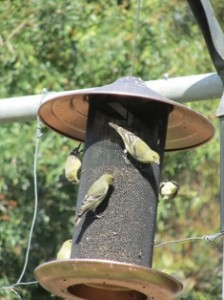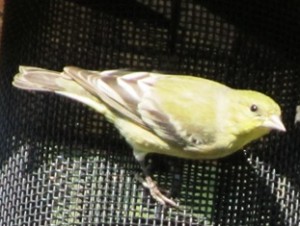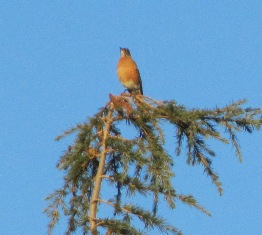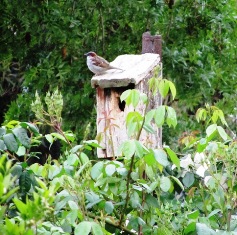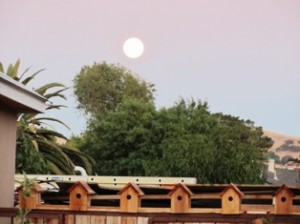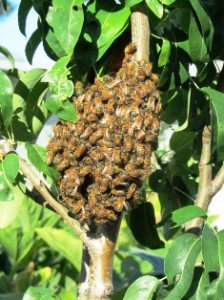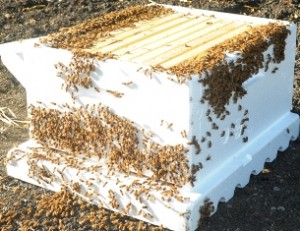Archive for the 'Animals' Category
Backyard Bird Watching Soothes the Spirit
Back in my old neighborhood I spent many happy hours watching the birds that flew into the massive pines behind my San Jose home. Then when I moved to the Miami area, I felt thrilled to spot a long-legged, white egret, a small but determined sandpiper, or a bald eagle or two visiting my home on the lake. The visits of those exquisite creatures were always brief and all too soon they would fly back to their nests in the brush or tall pines of the Florida Everglades, only a mile or two away. Now here on the Henny Penny Farmette, I am serenaded every morning by songbirds, often sweet little yellow finches feeding at the feeder five feet above the fence at the back of the property.
If you feed them, they will come. Finches love the black nyger seed. Our local feed store sells the seed in bulk and also in white mesh sacks with tiny holes perfect for finch beaks, which are quite small. Of course, some seeds will drop to the ground and, in my experience, easily sprouts and grows into a tall, skinny plant with a blue bloom. I’ve heard that you can sterilize birdseed so it would not root and grow if you toast the seeds for a short time in the oven on high heat. But be careful not to burn them. Not even birds like burnt food.
While making coffee this morning, I peered out the kitchen widow to see a beautiful bird with a rust colored breast perched atop the fifty foot pine. I believe it was a robin. Grabbing my camera, I got off a couple of shots before the bird took flight. I’m pretty sure I haven’t seen the last of that bird. Rain is coming again in a few days and robins love to hop around searching for worms. So regardless of what neighborhood I’m living in, I create habitat and put out food for the wild birds. It welcomes them and their presence nurtures my spirit.
Shelter for the Birds
An old birdhouse made by the Boy Scouts seemed like ornamental yard art until we attached it to a pole on the back fence and planted the Sally Holmes climbing rose beneath it. When early spring rolled around, we noticed a fine little specimen of a bird began flitting about the little wooden birdhouse. He liked the proximity of the house to perching places, among them, the climbing rose and nearby fig, apricot, and pepper trees.
The amenities were also nice. There was the birdbath below in the middle of a flower box, plenty of seed in the bird feeder, and clumps of bushes in which to flit about. He and his lady friend promptly moved in and began building a nest.
My husband Carlos, the architect, decided to refine the birdhouse with a snazier design. He used painted boards. But the birds liked the rough-hewn, unpainted wood of the house the Boy Scouts had made. Other birds came to check out the new row of houses, but so far none have moved in.
Carlos has remained undaunted. These little birdbrains just didn’t appreciate the beauty of what he was trying to give them, he reasoned. So he created what we have begun to call “the low rent district,” a series of unpainted birdhouses of simple design built together onto a trough that Carlos fills with seed to attract them. So far, this cluster of houses out in the open do not seem to have the appeal of the more rustic one atop the pole on the back fence.
Birds like security and safety for their nests, just as humans do. Hence, location of a birdhouse to woodlands and brush-filled fields is preferable to a birdhouse out in the open. The entrance into the birdhouse (the hole) size is equally important. Our little feathered lodger doesn’t want a nasty blue jay or other marauder raiding the nest he and his mate have painstakingly built for their eggs and hatchings.
Lately, we’ve noticed the little bird who moved in last year (and filled our yard with lovely song) is back. It’s only November, so he and his mate must be planning an early move-in, maybe before other birds notice the house is currently unoccupied. What’s that old adage, the early bird gets the worm? Well, around here, it’s the prime real estate; unless, of course, you don’t mind living for a bit in the “low rent district.”
Protecting Honeybee Hives
In early October, I helped my beekeeper neighbor medicate his honeybees as well as the bees in the hives he had given me. Our work will ensure the bees make it through the winter. Although some beekeepers do not believe much in the value of medicating bees to ensure the health of the colony, my neighbor (who learned beekeeping at the knee of his father) maintains a healthy colony of bees that are flourishing and producing large quantities of honey.
Healthy bees are necessary for pollination of our nation’s crops. For reasons not well understood, roughly one-third of all the U.S. honeybee colonies have disappeared since 2006 when beekeepers in America and Europe sounded the alarm that worker bees were not returning to their hives and disappearing at alarming rates. Initially beekeepers and scientists postulated that the honeybee problem could be traced to infection by mites, a fungus, a weakened immune system, contact with pesticides, and/or stress or combinations of several factors. More recently, studies are suggesting that the CCD problem possibly is related to the use of neonicotinoids, a new class of pesticides introduced in the 1990s.
Chemically linked to nicotine, neonicotinoids are associated with diminishing bee populations in several new studies, although the Agriculture Research Service (ARS), the internal research agency of the U.S. Department of Agriculture, asserts that little is known about the causes of CCD. The ARS offers the following advice to beekeepers: “mitigation must be based on improving general honey bee health and habitat and countering known mortality factors by using best management practices. This includes supplemental feeding in times of nectar/pollen scarcity.” See, http://www.ars.usda.gov/News/docs.htm?docid=15572#bk
Commercial beekeepers feed their bees corn syrup and neonicotinoids have been used routinely on corn. Recently, Harvard Professor Chensheng Lu was quoted in a New Yorker article as stating he believes one reason for CCD is the “link between high-fructose corn syrup and use of neonicotinoids.”
So while my neighbor and I can medicate against pathogens and parasites, we will be watching to see what the EPA, the USDA, and other governmental agencies decide about the widespread use of pesticides and specifically the use of neonicotinoids.
 Facebook
Facebook Goodreads
Goodreads LinkedIn
LinkedIn Meera Lester
Meera Lester Twitter
Twitter



